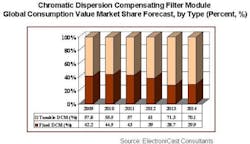ElectroniCast: Outlook favorable for filter-based chromatic dispersion compensator modules
JANUARY 28, 2010 -- ElectroniCast Consultants, in a new market forecast and analysis report, says that things should soon start looking up for manufacturers of filter-based chromatic dispersion compensator modules (DCMs).
“In the larger picture of optical networking, DCMs will continue to be required; therefore, our market analysis shows no declining in consumption of filter-based DCMs in the 2009-2014 forecast period,” said Stephen Montgomery, president of international business at ElectroniCast. “The alternative technologies to the dispersion-compensating fiber (DCF) based product-line are much more advanced than in previous years, and now in 2010, as we are just getting out of GD-2 (“great-depression number two), the market forecast for filter-based DCMs is very promising.”
There are three common device techniques to deal with chromatic dispersion in optical networks -- the use of dispersion-compensating fiber (DCF); the use of chromatic dispersion-compensating filter modules; and electronic dispersion compensation (EDC) chips, ElectroniCast Consultants notes. The new report presents a market review and forecast of the use of fiber-optic chromatic dispersion compensating filter modules in optical networking. Currently, these modules are typically composed of fiber Bragg gratings (see "Proximion debuts customizable DCM" for an example) or etalon-based elements, the firm says.
The market analysis covers:
- Fixed DCM (which are packaged/used in component or module format)
- Tunable (variable) DCM (which are packaged/used in component or module format)
“Network planners are expected to use the combination of improved fixed-type (plug-in and in-line jumper types) DCMs and tunable per-channel compensators, especially when concerned with adding more channels (WDM), footprint size of the DCM, and higher transfer rates, 2.5, 10, 40 Gbps, and beyond,” Montgomery concluded.
In terms of consumption value, tunable (variable) DCMs used in optical communications networks held a 57.8 percent relative market share of filter-based dispersion compensation devices in 2009. In 2014, as the use of higher transfer rate links increases, the need to automatically adjust the compensation will also increase, says ElectroniCast Consultants; therefore, filter-based tunable DCMs are forecasted to dramatically increase to 70 percent of the relative market share of filter-based DCMs (see figure).
This market forecast report is available immediately from ElectroniCast Consultants.
Visit ElectroniCast Consultants
